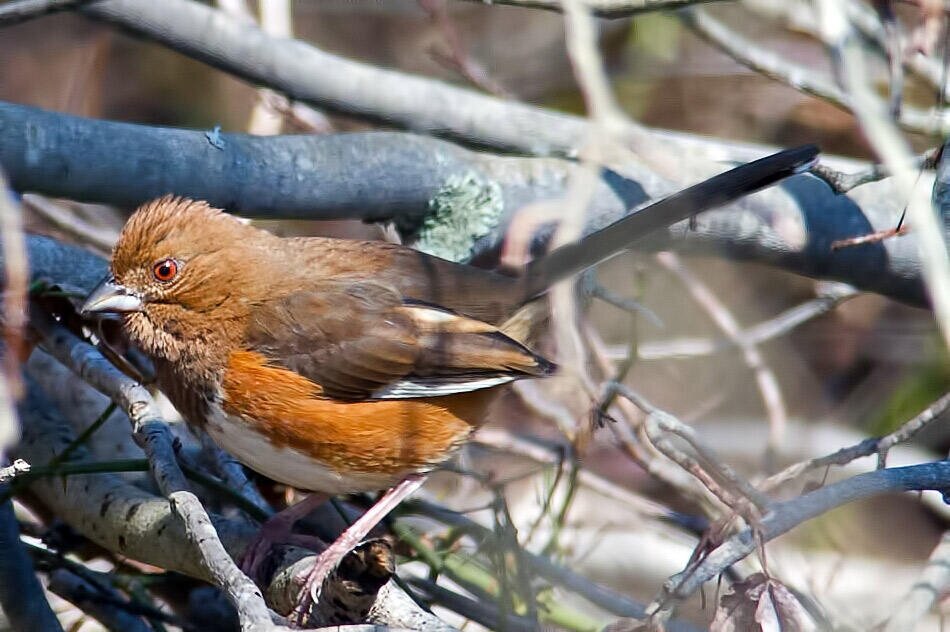Audubon at Home Sanctuary Species
Eastern Towhee (Pipilo erythrophthalmus)
Eastern Towhee - Una Davenhill/Great Backyard Bird Count
Large, secretive black, white, and rust-colored sparrows, Eastern Towhees flourish in brushy habitats in woodlands across the Eastern United States. Towhees feed on the ground under bushes and shrubs, and can be helped by protecting brushy forest understory from over-browsing by deer and by planting additional patches of native shrubs as nesting, foraging, and roosting habitat.
To learn more about ID, range, breeding, and voice, visit Cornell’s All About Birds
| What Eastern Towhees Need | How Can We Help |
|---|---|
| Food and Water:
Eastern Towhees are omnivorous, eating a wide variety of seeds, fruits, and especially insects, spiders, and sowbugs found in leaf litter under bushes and shrubs. Usually found in the middle of shrubby patches, they only rarely venture out from beneath low overhanging shade or cover. They consume a variety of weed seeds including ragweed, smartweed, and native grasses, and also feed on acorns and fruit, including blackberries, blueberries, elderberries. Towhees will drink and bathe in birdbaths, small ponds, or water drips in their brushy habitat. |
- Plant or maintain 20 x 20 foot patches of fruiting native shrubs and bushes, including viburnums, bayberries, blueberries, briars, wild grapes.
- Refrain from pruning large patches of shrubs in yard to provide roosting sites. - Avoid using pesticide on fruiting trees and shrubs and on insects near nesting bluebirds. - Allow tangles of briars and brambles or wild grapes to take over field edges or forest clearings. - Leave the leaves! Allow leaf litter to accumulate under bushes to provide foraging opportunities. - Towhees will come to commercial bird seed including millet and sunflower seeds spread on the ground or a low platform feeder below shrubs and bushes. - Provide a birdbath, small pond, or water drip near bushes where Towhees forage. Keep water clean, fresh, and free of mosquito larva. |
| Shelter: They roost and sleep 9 to 15 feet high in thick vegetation. | Consider methods of deer control if shrubby habitats are overbrowsed by deer. |
| Nesting: Eastern Towhees nest in habitat with dense low trees and shrubs and thick leaf litter, including overgrown fields and forests with a thick understory. They place their nests on the ground at the base of grass or a shrub, or in low branches of bushes, briars, or shrubs. | Avoid use of pesticides that kill insects that towhees eat, and herbicides that destroy their brushy habitat and weedy plant foods. |
| Other Threats: Since they nest and feed close to the ground, Towhees are especially vulnerable to attack by roaming house cats. Towhees nesting near homes may collide with picture windows. | - Keep pet cats indoors to keep them safe from outside hazards and to protect native birds, especially ground-foraging birds like Towhees. Remove feral cats from the neighborhood. Screen windows or make them visible so Towhees can avoid colliding with them. |
Where to see Eastern Towhees and their Habitat: Visit wooded sites with dense understory, or overgrown, brushy fields and scrublands.
Sully Woodlands
Find more using eBird Data: Narrow the view by entering your county in the “DATA FOR:” filter


